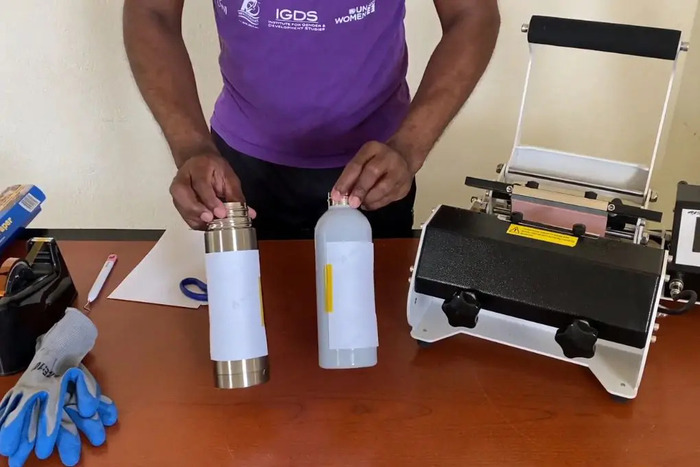Sublimation is a specialized coating that creates printable images directly on the metal surface from sublimation printers. Sublimation coatings are used in many industrial applications, such as packaging and labels. The advantages of using sublimation are many compared to other types of coatings. You can create patterns with intricate details and a high-resolution image with sublimation. Sublimation coating for stainless steel is ideal for applications that require chemical, oil, and humidity resistance. It’s also a popular coating for surgical instruments because it’s hypoallergenic and sterilizable. This article will walk you through the steps to make your sublimation coating solution for stainless steel at home.
What is Sublimation Coating?
Sublimation is a process that creates a transfer coating directly on the metal surface. The layer would then dry in a process called ‘curing’, usually carried out in a vacuum. The sublimation coating does not require any solvents, solubilizers, or layers. It is a dry process that creates an image directly on the metal. This makes it ideal for applications where coating solutions can interact with the substrate, like food packaging and medical devices. It is also a popular coating for surgical instruments because it’s hypoallergenic and sterilizable. This process is called interlinking, making the metal or plastic substrate impermeable to liquids and gases. This is great for applications requiring chemical, oils, and humidity resistance. It’s also a popular coating for surgical instruments because it’s hypoallergenic and sterilizable.
Benefits of Using Sublimation Coating for Stainless Steel
High-resolution images
Sublimation coatings can create images with intricate details and high-resolution images. This makes it ideal for applications where coating solutions can interact with the substrate, like food packaging and medical devices.
No solvents
Sublimation coatings are dry processes that create an image directly on the metal or plastic substrate. This makes it ideal for applications where coating solutions can interact with the substrate, like food packaging and medical devices.
Resistance to Chemicals, Oils, and Humidity
The metal surface is impermeable to liquids and gases and therefore resists chemicals and oils. This is ideal for applications where resistance to chemicals, oils, and humidity is required, like food packaging and medical devices.
Steps to Make Sublimation Coating For Stainless Steel
1. Clean the Stainless Steel Surface – This is the most crucial step when making sublimation coating for stainless steel at home. You should always clean the surface with detergent to remove any oils, dirt, and grease.
2. Prepare the Substrate Solution – Once you’ve cleaned the stainless steel surface, you will need to make a sublimation coating solution. You can do this by dissolving the resin in the solvent. When mixing the two, you want to make sure to dissolve the resin but not to get any traces of the solvent left in the solution.
3. Apply the Sublimation Coating – Once you’ve prepared the sublimation coating solution, you can apply it to the stainless steel surface using a sprayer for continuous coating.
4. Dry the Substrate – Once you’ve applied the sublimation coating to the stainless steel surface, you will have to dry it. A sublimation coating is a simple polymeric coating that will dry on the substrate surface.
5. Clean the Substrate – Clean the stainless steel surface again to remove any coating residue and any dust or remnants of the coating solution.
6. Finish the Job with a Heat Treatment – Sublimation coatings are very durable. Therefore they generally don’t need any post-treatment. However, you can heat treat the coated substrate to improve durability and prevent your print from getting faded.
Equipment Required For Sublimation Printing
- Sublimation Coating Solution – There are many sublimation coating solutions on the market, but you can make your own at home. It should have the right amount of solvents, pigments, and other ingredients to achieve the desired results.
- Substrate – This is the metal or plastic surface you will coat with your solution. It can be any metal, but stainless steel is the most common.
- Spray Bottle – This is a must-have when you make sublimation coating for stainless steel. You can use it to apply the coating solution to the substrate and also apply the drying agent.
- Vacuum Dryer – A vacuum dryer is used to remove the moisture in the air, thereby making the coated substrate airtight. It can be used to coat any substrate, even wood.
- Heating Device – Sublimation products must be heated to a specific temperature, and a heating device does just that. It makes the coating solution ready for sublimation printing.
- Engraving Knife – A sharp engraving knife is ideal for cutting the coating from the substrate.
- Scale – A standard balance beam weighs the substrate and ensures the coating solution is applied evenly.
- Measuring Cups – This is a must-have for making sublimation coating for stainless steel at home. You can use it to measure the solvents, pigments, and other ingredients.
- Measuring Spoons – These are used to measure the number of solvents in the coating solution.
- Glass Stopwatch – This measures the time it takes the coating solution to dry.
- Balance – A standard balance is used to check the coating solution is applied evenly.
Conclusion
Sublimation is a specialized coating that creates printable images directly on the metal surface. This process does not require any solvents and is dry, creating an image directly on the metal. It’s a popular coating for surgical instruments because it’s hypoallergenic and sterilizable. This process is called interlinking, making the metal or plastic substrate impermeable to liquids and gases. It’s also a popular coating for surgical instruments because it’s hypoallergenic and sterilizable. The advantages of using sublimation are many compared to other types of coatings.
